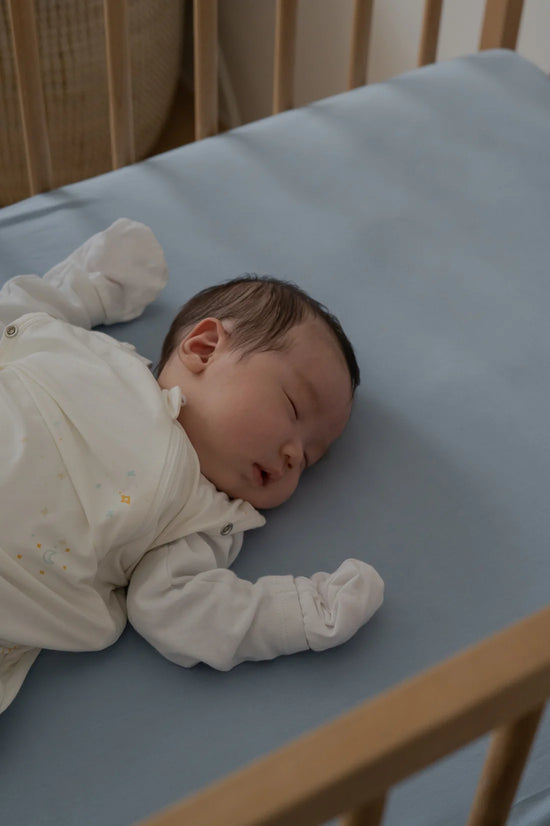Bringing a newborn into the world is a truly magical experience, filled with joy and wonder. As first-time parents, you embark on this incredible journey of nurturing a new life. Along this path, you may encounter various challenges and learning experiences, one of which is the art of swaddling.
Many first-time parents are introduced to a baby swaddle by the skilled hands of nurses in the hospital. These healthcare professionals expertly wrap your precious bundle in a snug, cosy blanket, showing you how to calm and soothe your newborn. It's a reassuring sight, watching your baby peacefully nestled in their swaddle.
However, when it's time to transition from hospital to home, the prospect of swaddling alone can be both exciting and intimidating. Questions may arise: "Am I doing it right? Is my baby comfortable? What if I wrap them too tightly or too loosely?" These fears are entirely normal for new parents, and we're here to guide you through this essential aspect of infant care.
In this guide, we will walk you through the proper way to swaddle your baby, helping you gain confidence and ensuring both your newborn and you are comfortable throughout the swaddling experience.
What is Swaddling?
Swaddling is a common practise that involves gently covering a baby in a light, permeable blanket to help them relax and sleep. Only their bodies should be wrapped, not their necks or heads. The idea is that swaddling your baby would make them feel safe and comfortable, similar to how they felt in their mother’s womb.
Why is Swaddling Important?
- Swaddling your infant shields them from their natural startle reflex or moro reflex, resulting in greater sleep for both of you.
- It reduces anxiety in your baby by simulating your touch, allowing them to learn to soothe themselves.
- It keeps their hands away from their face and protects them from scratching.
- It allows your infant to sleep longer and more soundly.
- It helps to avoid SIDS by removing unnecessary things out of your baby's cot, such as cushions, blankets, and stuffed toys.
- It keeps your baby sleeping on their back.
How to Swaddle a Baby
- Fold the baby swaddle in a triangle and place the baby at the center.
- Place the baby's right arm alongside the body and pull the baby swaddle across the baby’s chest with the right arm underneath the swaddle.
- Fold the bottom corner of the baby swaddle up and over your baby’s feet and tuck the fabric into the top of the swaddle.
- Place the baby's left arm alongside the body and pull the baby swaddle across the baby’s chest with the left arm underneath the swaddle.
Types of Baby Swaddles
There are different kinds of baby swaddles that the parents can choose from to swaddle their babies:
Traditional Baby Swaddle:
A traditional baby swaddle is a big, thin blanket that is folded and wrapped around a newborn to keep them warm, tight, and safe. It is generally made of soft, flexible fabric like muslin, cotton, or bamboo. To wrap tightly around your infant, blanket swaddles should be squares with minimum edge lengths of 45 inches.
Pros:
- As your child develops, you may continue to use the same blanket size.
- Because of its versatility, you can experiment different swaddling ways.
- Swaddle blankets are inexpensive and readily available.
Cons:
- Mastering the wrapping method can be difficult.
- If not wrapped properly, a swaddle can fall undone, which can be harmful for your infant.
Swaddle Sacks:
Swaddle sacks are a wearable blanket that is a hybrid of a sleep sack and a standard baby swaddle. It is safer for newborns since it does not come undone as quickly. To keep a baby's arms close to his sides, swaddle bags might include velcro, zippers, or snap closures.
Pros:
- Very easy to fasten.
- They are available in multiple sizes.
- No learning curve to use
Cons:
- Babies can grow strong enough to break out from their confinement.
- Velcro fasteners have a tendency to wear down over time.
- It's only safe to use until your baby starts rolling over.
- Velcro may be loud and inconvenient.
Swaddle Pods:
These baby swaddles are composed of stretchy elastic fabric and zip up to completely envelop your baby, giving them a womb-like experience. Swaddle pods are particularly useful since their flexible form allows the baby to move his or her limbs more freely, reducing the risk of hip issues.
Pros:
- Simple to use
- Allows your baby to extend his or her limbs more freely.
- Convertible models are safe to use even after your baby learns to roll over.
Cons:
- They are useful for a short amount of time.
- As the baby starts growing, different sizes are required.
Materials for Baby Swaddle Blankets
- Cotton muslin: It is incredibly lightweight, which makes them a great fit for summers. Cotton is also a particularly breathable fabric, enabling perspiration and moisture to escape. This helps to keep your baby cool and quiet as they sleep by regulating their body temperature.
- Jersey Knits: They are usually made from a cotton blend or synthetic fibers, and are one of the longest lasting materials available. It can resist a lot of use and wash cycles without losing its shape. The jersey knit fabric, like cotton muslin, is extremely breathable, which is ideal for newborns who sweat while sleeping. Sweat evaporates quickly, keeping the infant dry and content.
- Bamboo: Bamboo baby swaddles are composed of bamboo viscose, a fabric that is three times softer than cotton and hypoallergenic. The bamboo material contains bamboo kun, a natural antimicrobial, that protects the baby against skin allergies.
- Polyester: Polyester is used to make baby swaddles because of its soft texture. Because of its strength and durability, it lasts longer. The material is also highly flexible, allowing your baby to extend his or her hips and legs without feeling restricted. Polyester baby swaddles are wrinkle-resistant, easy to dry, and do not shrink.
- Fleece: It is a good choice for baby swaddles during winters because of its heat trapping properties. They are also soft and dry up quickly.
Is Swaddling My Baby Safe?
Yes, swaddling your infant is safe and can be an excellent approach to relax your baby and encourage sleep, according to the American Academy of Pediatrics (AAP). When you put your baby down to sleep, make sure they are on their back, but this is especially important when they are swaddled.
Tips for Safe Baby Swaddle
- To ensure your baby's comfort and safety, opt for a swaddle blanket made of breathable materials. Lightweight blankets can also help prevent your baby from overheating while swaddling.
- One common mistake to avoid is wrapping the swaddle too tightly. While a snug swaddle is beneficial, it's essential not to restrict your baby's movements or compress their chest. A comfortable baby swaddle should allow for gentle movement within the blanket.
- While swaddling, it's also crucial to allow for proper hip development. To achieve this, ensure your baby's hips are in a natural "frog-like" position, this allows their legs to be able to move freely and reduce risk of hindering proper development.
- Always make sure your baby's face is uncovered when swaddling. Their nose and mouth should be free to ensure proper airflow and reduce the risk of suffocation.
- As your baby grows, you may need to transition away from swaddling. Once your baby shows signs of trying to roll over, it's time to discontinue swaddling to prevent any potential hazards associated with restricted movement.
When To Stop Swaddling?
When the baby is able to roll, swaddling must stop. This can happen as early as 2 months. Doctors fear that when babies roll to the stomach, they might not have free hands to push up and allow their face to breathe.
Baby Swaddle or Sleep Sacks?
A sleep sack is a type of wearable sleeping bag that functions more like a blanket without the dangers of unfastened blankets. There's also plenty of room for the baby's legs and hips to stretch. A baby swaddle, on the other hand, creates a tighter fit for your infant, simulating the comfort of the womb. When deciding on the type of sleepwear for your infant, keep in mind his or her developmental stage and safety. We recommend keeping baby swaddles for newborns since they make them feel more comfortable and lower the risk of SIDS and using a sleep sack when your baby starts to grow.



